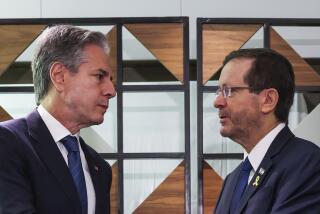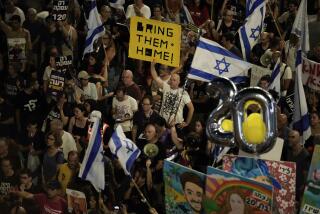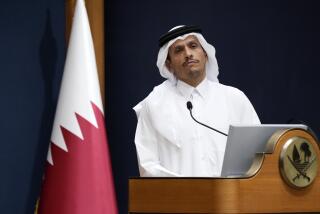Vietnam Takes Hard Stand on Cambodian Peace Settlement
BANGKOK, Thailand — With the tempo of talks picking up, Vietnam has dug itself into a hard position on a settlement of the war in Cambodia.
Deputy Foreign Minister Tran Quang Co has labeled “absurd” a renewed Thai proposal for a three-stage withdrawal of Vietnamese troops from Cambodia and the deployment of an international peacekeeping force.
“The Thai proposal has grossly trampled on the sacred principles of respecting the national sovereignty . . . of the Kampuchean (Cambodian) people,” Co declared in a statement released by Hanoi’s official Vietnam News Agency last week.
Disputed Concept
The sovereignty of Cambodia is a disputed concept in the search for a solution to 10 years of war. Thailand, its allies in the Assn. of Southeast Asian Nations (ASEAN) and Cambodian resistance forces insist that Vietnam violated the sovereignty of the beleaguered country with its December, 1978, invasion and the formation of a pro-Hanoi regime.
The question of who wronged Cambodia will be the central topic this week at two key discussions:
-- On Wednesday, the U.N. General Assembly is scheduled to begin its annual debate on the Cambodian situation. This year’s ASEAN-sponsored resolution again blames Vietnam for the war and demands the withdrawal of its troops--but has an added twist. It advocates a political solution implicitly designed to prevent the return to power of the Khmer Rouge, the tyrannical regime driven from power by the Vietnamese army.
-- On Saturday, Prince Norodom Sihanouk, the one-time Cambodian leader, will begin two days of talks in Paris with Hun Sen, premier of the Vietnamese-installed regime in Phnom Penh, Cambodia’s capital.
Sihanouk, who as king and prince headed the Phnom Penh government from 1941 to 1970, seeks to return as head of an interim, pre-election government made up of three resistance factions and the Hun Sen government. Hun Sen, supported by Hanoi, has invited the prince to return to a high, but not ruling, position in his own government.
Peace talks have gathered momentum in the past year, beginning with the first, inconclusive round of Sihanouk-Hun Sen talks in France last winter. In July, at a resort outside Jakarta, Indonesia, Hun Sen met directly for the first time with leaders of the resistance factions in a conference also attended by Vietnamese Foreign Minister Nguyen Co Thach and representatives of the ASEAN nations.
Little common ground was found, and a working group met again in Jakarta earlier this month, where Thailand put forward the proposal that drew Vietnam’s ire last week.
A Vietnamese proposal met equally strong rejection. For the first time, Hanoi called for Cambodian refugee camps in Thailand near the Cambodian border to be relocated farther inside Thailand, separating the resistance guerrillas from their civilian supporters.
Seek Cuts in Aid
The Vietnamese also proposed that military aid to the resistance, supplied primarily by the Chinese, be reduced and eventually eliminated in tandem with any Vietnamese withdrawal.
“It’s a non-starter,” said Sarasin Viraphol, a Thai Foreign Ministry official, of Hanoi’s demand, noting what he termed the just cause of helping members of the resistance liberate their country.
In turn, ASEAN proposals for international peacekeepers to enforce any settlement have been flatly rejected by Hanoi, the Hun Sen government and, until about 10 days ago, by the Khmer Rouge, whose surprising turnaround on the issue has diplomats puzzled.
Earlier this month, in an interview in Hanoi, Gen. Tran Cong Man, editor of the Vietnamese army newspaper, explained his government’s position on a peacekeeping force.
“Why do we need such a force if there’s a political agreement?” he asked. “Tell me where an international peacekeeping force has worked? It would just mean another foreign army on Cambodian soil. If we have an agreement, there should be no trouble.”
Deployment of peacekeeping units, he argued, would divide Cambodia into areas of factional control, “like Lebanon.”
Military analysts agree that the two strongest forces in Cambodia are the Vietnamese army and the Khmer Rouge guerrillas, die-hard adversaries in the struggle for power. Sihanouk has supported the peacekeeping proposal primarily as a safeguard against a military takeover by the Khmer Rouge if the Vietnamese withdraw.
In August, the Khmer Rouge put forward its own peace plan, and professed agreement that none of the Cambodian factions, including its own and Hun Sen’s, should have sole power in Phnom Penh. Now, with its announced acceptance of the peace force idea, broadcast on Oct. 22 over the clandestine Khmer Rouge radio in Cambodia, the pressure on Vietnam may increase. “This is what we have asked for,” said Thai Foreign Minister Siddhi Savetsila.
There was no explanation of the turnabout by the Communist Khmer Rouge, which nominally is aligned in a coalition with the non-Communist guerrillas of Sihanouk and Son Sann, a one-time Cambodian prime minister.
Troop Withdrawal
Hanging over the political talks is Vietnam’s pledge to remove all its troops by the end of 1990, or by the end of March next year if a political agreement is achieved.
In May, Vietnam pledged to withdraw 50,000 troops from Cambodia this year, out of a total estimated between 115,000 and 125,000. In late June, it announced that 13,000 had been pulled out since the first of the year. Since June, according to Gen. Man, the Hanoi army newspaper editor, 2,000 a month have been withdrawn, a pace that would fall far short of the 50,000 target.
More to Read
Sign up for Essential California
The most important California stories and recommendations in your inbox every morning.
You may occasionally receive promotional content from the Los Angeles Times.










